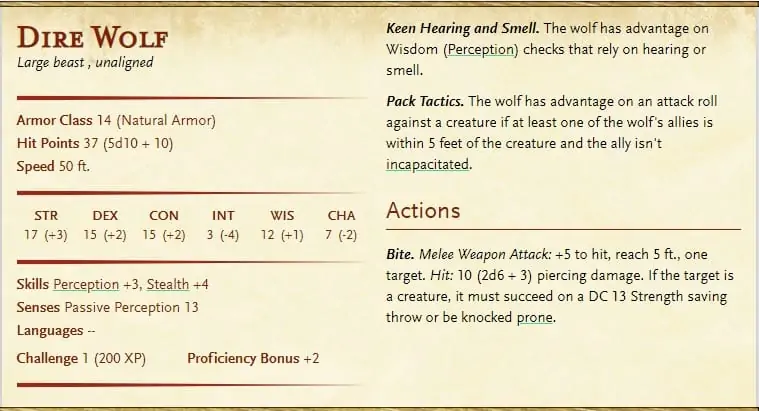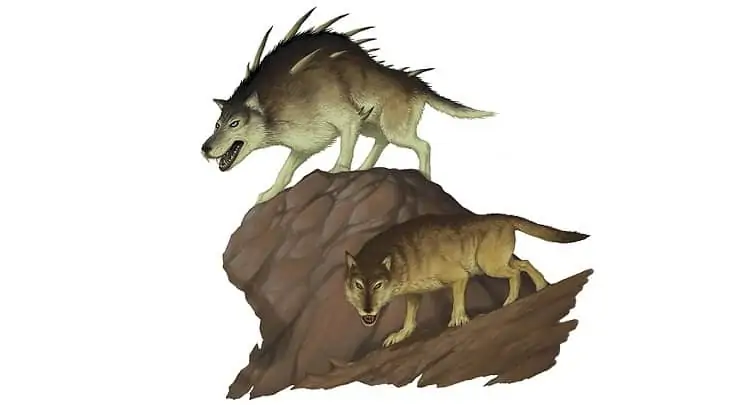It is late at night and the party is still moving through the woods. They have just killed a powerful necromancer, and now they are returning to safety in the town.
They are bleeding, bruised, and almost out of spells and items. Just as they think they are safe, they hear howls and a large wolf emerges from the woods. Take initiative!
Direwolves are larger and more dangerous than normal grey wolves. They are dangerous and should not be underestimated. Their size and strength can knock out most adventurers. They are often the only ones fighting.
What makes the DnD monster so dangerous? They are everywhere. How do you defeat them? This is our guide to the terrible wolf!
What is a Dire Wolf?
A Dire Wolf is an ancient grey wolf and is much larger than regular wolves. They average about 9 feet in length and weigh around 800 pounds. They can be aggressive and work alone or with 3-5 other wolves.
They have an AC of 14, an average of 37 hitpoints, 50 feet of speed, and these abilities.
Keen Hearing and Smell Wisdom (Perception) checks that depend on hearing or smell have an advantage for the wolf.
Pack tactics. If at least one of the wolf’s allies is within 5 feet of the creature, and the ally hasn’t become incapacitated, the wolf has an advantage in an attack roll against it.
Bite. Melee Weapon Attack: +5 to hit. Reach 5ft., one target. Hit: (2d6 + 3) piercing damage. If the target creature is a creature it must make a DC 13 Strength saving throw to succeed or be knocked unconscious.
These rules are broken down so that the wolf can hear or smell someone entering their territory. They are also good at working in groups, so if they are near an ally and both attack the same target, they will have an advantage.

The wolf also has a large bite attack that isn’t very dangerous. However, if they are attempting to bite a creature (and this includes humanoids), then they must roll a 13 on a strength check. The wolf will gain an advantage on their attack rolls if they fall, as they crush their victim.
Dire Wolf Tactics
A pack of three to five dire wolves will work together to take down the weakest member of the group.
They will flank, get close to each other, try to pull the target down with powerful jaws, and generally seek to gain as much advantage as possible.
They can also hit and run, using their speed to separate the party before returning around for another attack.
They can often detect or hear the party members long before they are visible and will use their stealth skills to sneak up on them to set themselves up for an ambush.
These wolves are aggressive and designed to kill. If you are caught in a fight with them, they will likely fight to the end.
This is unlike other wolves, who may only fight for their territory or hunt. They will run if they are hurt or prey leaves the area.
They are also very sensitive to blood and gore, just like regular wolves. Dire wolves can be aggressive if your party has been injured or bloodied in a previous fight.
All wolves understand that blood indicates that the target has been injured or is weak. Weakness means that they can be eaten, making it easier to bring them down.
Fighting Wolves In A Pack
Although dire wolves are more comfortable fighting alone than in a pack, they can have alpha wolfed their way to the top of any normal pack.
They can also fight with a pack of weaker Wolves, which causes a change in their tactics.
Wolf packs are always moving and will try to separate the party to get to the weakest member.
They will then run into the enemy and bite them. If they succeed in biting, normal wolves will position themselves around the enemy to make it easier for other wolves to exploit the pack tactics. The Dire Wolf will behave the same.
In the real world, wolves know how to hunt prey and avoid getting in their way. Instead, they will chase their prey and run towards them, trying to get the party to follow them.
After eating a few bites, it will be time for the real attack. The wolves will rush in greater numbers and circle the party, while others rush to attack the weakest members of the party.
They attack in pairs and try to gain an advantage over one another.
This will often continue until the party is defeated or approximately a quarter to half of the party has been injured or killed. They will run away if they become hurt.
How can you fight against the evil wolves?
Your players must be able to fight dire wolves whether they are working with their pack or leading one.
Their tactics of running and hitting can prove to be frustrating for melee players.
The best thing the heavily armored melee player can do is to back up, form a wall around their weakest members so that the wolves have to pass through them before attacking their friends.
Because they don’t have the greatest AC, magic-casting characters can easily target dire wolves.
Some AoE spells can help reduce the damage done to a lot of the pack. This strategy works as long as the dire wolves don’t attack them and then bring them down with their powerful bite.
The Dire Wolves are immune to all damage types. You can hit them with anything and they will take full damage.
Some DM’s play into the animal’s natural fear of fire and force wolves to take a will-save or panic when they encounter a fire spell.
Variants of Dire Wolves

Some dire wolves are great for making the fight more exciting if your party travels in the woods often.
They might hear of a gargantuan dire wolf with higher stats than traditional dire wolves and a pelt that resists magic. They can teleport according to legends.
The rune-bound dire wolves are another magical dire wolf and have runes covering their bodies. They can draw on those runes for abilities.
Others have made agreements with werewolves or other magical creatures to call upon their help and empower their brethren with a howl full of terror and bloodlust.
The endless walking through the woods can be made more exciting by fighting a few wolves, which could lead to epic and memorable battles.
Do Enemies Use Dire Wolves?
Some goblin tribes have used regular wolves to mount their animals, while orcs and bandits are known to have used wolves to attack and guard their members. However, dire wolves can be difficult to tell.
When compared to a large number of grey wolves around the world, dire wolves are quite rare. Their natural aggression makes it difficult to train them.
Perhaps an enemy druid, sorcerer, has one of these rare wolves as their pet or a ranger who keeps one as a companion.
These will not be the norm, however, so you won’t see too many dire wolves alongside the enemy armies marching on your villages and towns.
Countertactics
Adventurers need to be smart and make good use of their tools and resources to deal with these strategies.
Using readied actions to attack dire wolves as they rush by can be important; otherwise, a group might not be able to hit the wolves before they run back to cover (and eventually stealth).
Don’t let your group split up. Even if the party is only separated by a few squares, the dire wolves have a chance to pull weak members away from healing and help.
It is important not to be caught off guard. Be aware of your surroundings, especially at night when you’re camping.
Don’t let the dire wolves herd you; find a safe place and don’t try to run away. Your group might be able to scare them away if they can’t beat them.
Magic can also be helpful because it can get in the way of the dire wolves or hold them still so the party can kill them.
You can also quickly defend yourself with non-magical tools like caltrops or a line of burning oil. This turns the environment to your advantage.
Illusion magic like Major Image can also be a great way to get someone’s attention away from something.
The spell can make both images and smells, and dire wolves would rather go after an easy target than attack a group of people with knives and magic.
Just don’t try to become invisible! Dire wolve’s Keen Senses make it much harder to hide.
Even a large pack of dire wolves won’t be able to kill your party if you play smart, don’t split up, and use the environment to defend against dire wolf pack tactics. This is because survival is always a win.
Running Dire Wolves for DMs
As you should now see, dire wolves can be a much bigger threat than their CR 1 suggests if you use the right strategies. Even the player counter-tactics I mentioned can be beaten.
If the players start getting ready to act, one strategy based on how real wolves behave is for a dire wolf to run past the party after taking the Dodge action.
This starts any planned attacks from the party and gives the dire wolf a high chance of staying alive. Then, other dire wolves can attack without being hurt.
For especially dangerous fights, you might also want to make dire wolves weak to sound (since they can hear well) or fire (due to perhaps flammable fur).
A fight is always more interesting when there are weaknesses for players to find.
Don’t be afraid to point out that they don’t fight.
Having dire wolf mounts can be an interesting part of a culture, and having one of your characters do something really cool that scares the dire wolves can add a lot of depth to an otherwise simple fight.
Remember that dire wolves are big, horse-sized wolves with strong jaws, sharp senses, and friends.
Dire wolves might not be the most fancy fire-breathing creatures that can cast spells, but in the right hands, they can be very scary.
FAQs
Can a Dire Wolf be my Ally?
You have many options if you need to summon a familiar to assist you in battles or other situations. You have many options: bats, owls, mice, and snakes. It depends on whether you wish to become a dire wolf. Although the dire wolf is not allowed to be listed as familiar under the official rules, there are no restrictions on a player being allowed to have a celestial dire wolf if permitted by the DM.
Rangers can have a dire wolf as an animal companion. However, the problem is that a dire wolf is more intelligent than a regular Wolf. Your ranger will have an advantage if the dire wolf is used for some purpose. It might not be a game-breaker if the DM and player are aware of it and the player does not gain too much from the intelligence boost. It is not allowed in the official rules.
Druids may wonder if they can transform into a dire wolf by taking on a wild form. They can. This is possible at levels 1-5, thanks to the low CR of the dire wolf. Unless your DM is willing and able to homebrew, this is the only way you can have a dire wolf ally.
Can Dire Wolves Use their Claws?
The main weapon of the dire wolf is its powerful jaw. Other four-legged creatures also have claw attacks. You could also add a claw attack to dire wolves to make them more dangerous than other wolves. To balance the extra attack, make it weaker than the bite attack, and condition it.
Wolfes will normally bite their prey and drag them down. They will also use their claws to traction and run. Prey will be held in place by their claws, rather than being attacked. Perhaps the wolf will try to bite its prey with a bit of attack. Then they can use their claws to grapple with it.
Prey must make sure they don’t try to climb out of the cage and then wrestle the wolf with their claws. This would be more realistic than the real world. However, if you prefer to play fantasy games and less like the real world, you can give the Wolf very weak claw attacks.
Do Dire Wolves Fight to the Death?
Regular wolves will flee when the pack is too hurt or their prey is more difficult than they think. What about hyper-aggressive dire wolves? They are strong and focused on killing and battle, making it a DM decision. They might become too obsessed with killing to sustain their survival instincts. You could make them flee at 1/3 of their Hitpoints to show their toughness. They will be a formidable foe that your party will never forget! Navigation after navigation.








